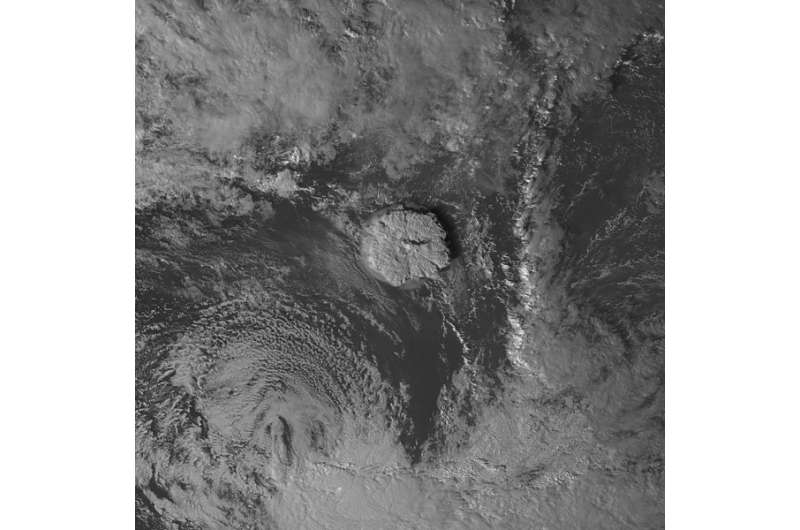Tonga Volcano Eruption 2022-01-15. Credit: Japan Meteorological Agency/NASA SPoRT. Wikimedia Commons, CC BY
A team of researchers at the University of Oxford, working with a colleague from the International Institute for Applied Systems Analysis, has created radiative transfer models to help estimate global temperature changes in the coming years due to the Tonga eruption last year.
In their paper published in the journal Nature Climate Change, the group suggests that the impact will be large enough to push average global temperatures temporarily above the 1.5°C increase limit targeted in the Paris Agreement back in 2015.
In January 2022, the Hunga Tonga–Hunga Ha'apai undersea volcano erupted with such force it sent massive amounts of ash, gas and water into the atmosphere. Unlike other large eruptions, the blast sent massive amounts of water (146 million metric tons) into the atmosphere, which has a warming effect. Because the blast was so powerful, much of that water made its way all the way up to the stratosphere, which means it will take many years for it to fall back to Earth.
In this new effort, the researchers used radiative transfer models to estimate the global temperature impact of blasting all that water into the stratosphere. They found a warming effect of 0.12 Watts per square meter, shortly after the blast. They then used the data from the model as input to a standard climate model to make estimations regarding likely average global temperature increases over the 10 years following the eruption.
The researchers plotted their estimates under two scenarios: low emission and moderate emission. Under both scenarios, the plots showed increased chances of average global temperatures exceeding the 1.5°C milestone in a given year. The first showed the possibility rising from 50% to 57%, while the second showed it rising from 60% to 67%.
The researchers suggest that if the 1.5°C milestone is reached in the next few years, it should not be considered a failure by the world community because it would be due to a natural factor. Thus, all efforts to continue reducing greenhouse gas emissions should continue as planned.
More information: Stuart Jenkins et al, Tonga eruption increases chance of temporary surface temperature anomaly above 1.5 °C, Nature Climate Change (2023). DOI: 10.1038/s41558-022-01568-2
Journal information: Nature Climate Change
© 2023 Science X Network
























